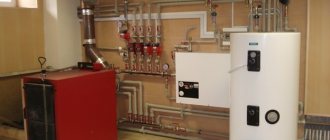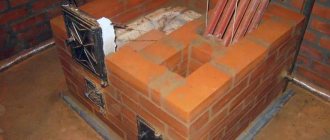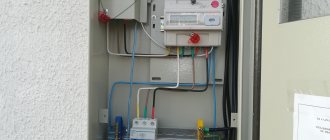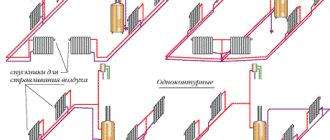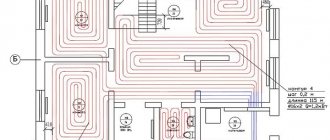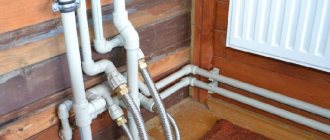It’s easy to calculate how much money is spent on electricity in an apartment. You go to the meter and look - and so on every month. What's in the apartment? Washing machine, TV, computer and a dozen light bulbs.
A completely different story is a private house. It is sometimes impossible to understand where such a figure comes from in a month, even for those who live in the house.
What if you are still a city dweller? If you still have plans to build a private house, and you are afraid that you will not be able to maintain it?
This is where our top-down calculations will help you - where the electricity goes in a private home.
Method 1 - electric convectors
With the help of electric convectors it is possible to provide a cheap and efficient heating system. The electric convector is built on the principle of natural air circulation. Warm air moves upward from the heater, thus stimulating the movement of air inside the room and ensuring uniform heating. However, a convector is effective only in warm climates, when the temperature does not fall below 10-15 degrees.
pros
- No forced air blowing. Even in the cleanest home there are particulates that lie on surfaces. When warm air is artificially blown out of a heater, this dust becomes part of the air we breathe. Natural air circulation is not so active, so dust does not rise into the air.
- Small size with sufficient power. The heating elements of convectors heat up quickly, converting electricity into heat with an efficiency of up to 80%. In addition, there is a system of operation in different modes, as well as thermostats that allow operation not constantly, but only when the air temperature drops.
- Mobility, allowing you to move the convector around the room, to places with maximum cold flow.
- The possibility of creating a heating system exclusively using convectors or using them as part of a more complex heating system.
- The electric heating element does not heat up more than 100 degrees, and the body - 60 degrees. They have an increased level of protection from moisture, which allows the convector to be used in the kitchen and bathrooms.
Minuses
- The disadvantage of electric convectors is the installation of heaters in every room of the house.
- In addition, if you turn them on at the same time, there is a possibility of exceeding the permissible power limits.
However, the disadvantages can be turned into advantages by installing a relay for turning on the heaters one by one. The relay will allow you to create a stable temperature in the house, reduce energy costs and remain within the permissible power limits. There is another argument in favor of a system of convectors - they will not all fail at once. Replacing one or two appliances without losing heat is not difficult.
The photo shows an electric convector from Nobo, Norway
Example of electricity consumption
For clarity, you can consider the organization of heating in a house with an area of 90 square meters. m, located in the Moscow region. There are electrical appliances with the following power consumption:
- water heater and washing machine: 1.5 kW each;
- 2 socket groups with 10 A circuit breakers, i.e. designed for a power of 220 × 10 = 2.2 kW each;
- internal and external lighting, supply and exhaust ventilation system with recuperator: total 1 kW.
The kitchen stove runs on bottled gas.
The total power consumption is 8.4 kW. 15 – 8.4 = 6.6 kW remains for heating.
The required rated power of the boiler corresponds to heat loss in the coldest week of the year + a reserve of 20%. To calculate them, a complex calculation is required, but a less accurate simplified version can be applied to a standard house: Q = S × K, where
Q – heat loss in the coldest week, W;
S – heated area, sq. m;
K – specific heat loss, W/sq. m.
Depending on the region, K is taken equal to a fixed value:
- southern regions: 60-80;
- central part of the country: 90-110;
- northern districts: 120-200.
According to the condition, the house is located in the Moscow region, we can assume that K = 100 W/sq. m.
Taking into account a reserve of 20%, the power of the heat generator in the coldest week will be:
W = 90 × 100 × 1.2 = 10,800 W = 10.8 kW.
Conclusion: to help the 6.6 kW electric boiler, it is necessary to install a solid fuel boiler - 4.2 kW. Or one combined one, running on wood and coal, but with heating elements in the heat exchanger.
Method 2 - tubular electric heaters
They transfer heat from a tubular electric heater to a liquid-based coolant. Typically, water and oil are used as a coolant, and sometimes antifreeze. The design principle of heaters is the same as that of electric kettles, which is why they are also called heaters and oil radiators. In fact, it is a boiler placed in a vessel with water. The efficiency of such devices is quite high, and heat loss for heating is minimal.
pros
- The undoubted advantages of tubular heaters include their safety, operational reliability and versatility of use.
- Can be used in both gaseous and liquid media.
- Not explosive, and not afraid of vibrations and shocks.
- Tubular heaters are available in a variety of design solutions, which allows you to economically heat a private home with electricity without disturbing the aesthetics of the interior.
Minuses
Heating heating elements have a high cost due to the expensive metals that are used in production. Since scale forms on the pipes, it is necessary to take care of the quality of the water.
A tubular radiator is a thin-walled metal tube with a spiral inside, so if you do not need particularly high temperatures, then you need to take a heater with carbon steel tubes. If the device must produce a consistently high temperature or operate in an aggressive environment, then you need to take a device made of stainless steel.
The photo shows a tubular electric heater made by yourself
Heating system installation
It is possible to positively resolve the problem - how to install heating in a private house (the diagram is given above) if you follow certain rules and the sequence of work. Installation work begins with the installation and subsequent piping of the boiler. Gas boilers with a power of up to 60 kW are installed in the kitchen. All rules for installing boilers are described in detail in the instructions for them.
Piping a heating boiler is the process of connecting the necessary equipment.
There are two ways to install a heating circuit from gas and water (metal) pipes - welding and using threaded connections. Of course, you can quickly create a system using the welding method, but it will turn out to be non-separable. By connecting the system pipes with threaded connections, you can easily change the configuration or replace any section of the pipeline at any time. For any installation method, the connection diagram for heating radiators in a private house requires special attention, and it must be drawn and calculated in advance.
Method 4 - electric boiler with heating element
The popularity of electric boilers is determined by their safety, low cost and reliability. Most consumers opt for heating element boilers - they are much cheaper than electrode and induction boilers, and they are easy to maintain.
However, due to the use of a thermoelectric heater (TEH), such heating cannot be called the most economical. In addition, before purchasing, I recommend checking the operating mode of the local electrical networks - perhaps the networks will not cope with the load you need and the purchase will be in vain.
The photo shows an electric boiler KOSPEL, Poland
The main advantages of individual electric heating
To understand all the benefits of electric heating, you need to compare it with other existing heating options for a private home. For example, what needs to be done to install a gas heating system? At a minimum, spend a fairly significant amount on purchasing the necessary units and set aside several weeks to go through various authorities and obtain the required permits.
Electric heating does not require any prior permits. You just need to buy equipment, install it yourself or with the help of installers, and connect it to the network. The entire work takes a day, rarely two.
Individual electric heating
Under any circumstances, you will spend less money on purchasing and setting up electric heating than on arranging a boiler room, laying gas pipelines and purchasing a boiler.
Electric heaters do not require a separate boiler room. Warm floors, convectors, fan heaters, infrared heaters - all this is installed in a convenient place, placed under the floor screed or hung on the walls.
Electric heaters do not require a separate boiler room
Gas heating is potentially dangerous. If connected and operated incorrectly, the boiler can poison the residents of the house or even explode
Electric heaters are completely safe, you just need to follow basic precautions
Electrical installations are much more reliable compared to central heating systems. By refusing central heating, the home owner frees himself from not the most profitable and convenient cooperation with utility services.
By refusing central heating, the home owner frees himself from not the most profitable and convenient cooperation with utility services
Electric heating does not force its owner to allocate a separate place for storing fuel and constantly think about the need to regularly replenish fuel supplies.
Electric heating does not force its owner to allocate a separate place for storing fuel and constantly think about the need for regular replenishment of fuel. Electric heating does not force its owner to allocate a separate place for storing fuel and constantly think about the need for regular replenishment of fuel.
The issue of the economic benefits of heating a house using electricity deserves special attention. Previously, it was believed that electric heating was the most expensive option for individual heating. And this statement was absolutely correct. Today the situation has changed dramatically.
- Firstly, the home owner can install a multi-tariff meter. In most regions of the country, electricity is charged differently during the day and at night. Thanks to such a meter, heating costs can be reduced significantly.
- Secondly, the system can be equipped with heat storage batteries. Such devices are connected to the network at night, when electricity is cheapest. When connected to the power grid, the internal elements of such storage devices, made of high-tech magnesite, accumulate heat, and after disconnecting from the network, they release the accumulated electricity into the house.
A compact sensor is responsible for the correct operation of the drive. It also helps regulate the temperature in the rooms and allows you to maintain a comfortable microclimate. The drives are absolutely safe and are sold at a relatively affordable price. You will, of course, have to spend more money on installing a heating system, but all expenses will pay off very quickly, because The devices considered can reduce energy costs by up to 5-7 times.
Method 5 - induction boiler
An induction boiler is a transformer with two types of winding. The resulting eddy currents follow the short-circuited loop, which is the boiler body. The secondary winding receives energy, which is converted into heat, heating the coolant.
Induction boilers heat your home quickly, can operate at low voltage, and have no parts that can fail. The efficiency of such a boiler is almost 100% and does not depend on the service life.
The photo shows an induction boiler EPO Evan 9.5 kW, Russia
Electricity costs for heating a house
The boiler reaches its rated power mode only during the coldest five-day period of the year. The rest of the time it operates with reduced heating output. On average it is:
- in the winter months (December, January and February): 50% of nominal;
- in November and March: 30%;
- in October and April: 15%.
For example, a 10 kW electric boiler will consume:
- During the winter months: 10 × 0.5 × 24 hours × 90 days = 10,800 kWh.
- For November and March: 10 × 0.3 × 24 × 61 = 4,392 kWh.
- For October and April: 10 × 0.15 × 24 × 61 = 2,196 kWh.
Total: 10,800 + 4,392 + 2,196 = 17,388 kWh.
In 2022, in the Moscow region, the tariff for houses with electric stoves and heating corresponds to 3.89 rubles/kWh. This means that the costs for the season will be 17,388 × 3.89 = 67,639.32 rubles.
Accordingly, if we talk about an electric boiler for heating a house of 200 square meters, the amounts will be much higher.
Method 6 - electrode boiler
Inside the electrode boiler there are electrodes, which act as a heating element. When current passes through a liquid, heat is generated. This means that in electrode boilers there is no actual heating element on which scale could form. The absence of scale will greatly facilitate operation.
Electrode boilers are highly reliable and operate much longer than tubular heaters. In addition, they are small in size, which is very convenient for a small residential building. The disadvantages include high requirements for the liquid used as a coolant. Water must undergo special treatment. Often, antifreeze generally must be exclusive - from the device developer.
The photo shows an electrode boiler Galan, Russia
Possible options
Before you begin choosing suitable heating equipment, you need to decide on the configuration and relative arrangement of the elements of the heating system. You can achieve the desired result in different ways. Electricity can be used to heat a country house.
- intermediate coolant. The option involves installing a heating circuit within which the coolant continuously circulates. As it heats up, the pipe begins to release heat into the surrounding space, gradually warming the air to the optimal level. To implement such a scheme, a project is first developed. The characteristics of the elements of the future system and their spatial location relative to each other are calculated. The optimal location is selected;
- devices with direct heat transfer. Such equipment allows you to avoid installing a heating circuit. Heat is transferred directly from the source to the surrounding space. They are less inert compared to the previous version.
When using an intermediate coolant, special attention is paid to the order of pipe routing. She may be:
- one- and two-pipe. The latter option allows you to create comfortable conditions in all rooms at the same time. The heated coolant is supplied through one pipe, and the cooled coolant is sent to the boiler through another;
- horizontal or vertical.
Special attention is paid to the installation location of radiators. They must give off heat in full, ensuring uniform heat distribution throughout the entire interior space. The most effective and efficient layout is considered to be one that involves placing radiators around the entire perimeter of the room.
Method 7 - infrared heaters (the most economical)
Infrared heaters are considered the most economical of all types of electric heaters. They do not need heating elements and water pipes. Infrared heaters heat objects, not the room. Then the heated objects heat up the air. If an electric boiler can be compared to a kettle, then an infrared boiler can be compared to a microwave oven.
Infrared panels are especially popular. They are installed on the ceiling or walls of residential and industrial premises. Since the heating area is increased, the room becomes warmer faster than usual. Such a panel can be used as an independent heating source or as an addition to an existing system. An infrared heater goes well with electrode boilers. For example, an infrared heater can only be turned on in spring and autumn, when it is too early to turn on the main heating, or when it suddenly gets cold outside.
Pictured is a GROHE infrared panel, Germany
Features of two-pipe circuit wiring
The two-pipe system comes in several varieties. They have a different connection diagram for heating radiators in a private house, and a different vector of coolant movement.
In small private houses, the following types of two-pipe heating systems are used:
Brief characteristics of two-pipe systems
Dead-end system - the entire pipeline network consists of two arms (branches), one for supply and the other arm for coolant return. The movement of water occurs in counter directions.
Associated two-pipe system - the return arm serves as a continuation of the supply arm (branch), i.e. the system is looped. This heating connection scheme in a private house is deservedly popular.
Collector is the most expensive heating distribution scheme for a private house due to the need to lay pipes to each battery, and their installation is hidden.
Open "gravity" two-pipe system
Let's consider the heating system installed in a private house with our own hands; a two-pipe open circuit was selected and an open tank was installed at the top point of the circuit. The pressure that determines the speed of fluid movement in the “gravity” system depends on the height of the tank. The main advantage of a two-pipe system is that water flows to the radiators at the same temperature, and a clear separation of pipelines into supply and return makes it easier to automate control.
For successful operation of the “gravity” system, a slope of 3-5 mm/m is ensured during installation. Due to gravity, any type of heating system can operate if the necessary conditions are created - the slope of the coolant supply lines for natural circulation. It must be taken into account that the “gravity” system can only work with an open expansion tank.
Closed two-pipe system
When installing steam heating in a private house, the scheme is chosen to be closed, and its type depends on the number of floors of the building. If the house is one-story, then two pipeline branches are laid - supply and return, and heating devices are connected to them in parallel.
And in order to install the heating of a two-story private house with your own hands, the wiring diagrams must contain the required number of liquid supply branches. One branch of the collector should power the batteries on the upper floor, the second branch should power the batteries on the lower floor. The water that has given up its heat returns to the boiler through the “return”. A closed system must have a circulation pump to create pressure.
conclusions
- It is generally accepted that heating a house with electricity is not cheap. This is certainly true if we mean only payment according to tariffs. However, to the price of heating you need to add the cost of the equipment, as well as the costs of its maintenance and repair.
- If you compare bills for electricity, firewood, coal, pipes, boilers and other equipment, you can come to the conclusion that private heating with electricity is cheaper than solid-state boilers, stoves and other systems alternative to gas heating.
- In addition to money, there is another argument in favor of electric heating - it saves time: turn it on, leave and forget. The only downside is a sudden power outage.
Below, watch a video about how we managed to create cheap heating with electricity for a large private house.
We heat with gas
Gas heating can rightly be considered more profitable if the gas pipe is located in close proximity to the house. To save on connecting to the highway, it is recommended to use the following rules:
- All services must be ordered in one place. This includes design, installation and subsequent service;
- It is necessary to properly prepare the place for the boiler;
- The boiler itself must correspond to the area of the house;
- You should choose the optimal size of the chimney.
The main advantage of gas heating is the low cost of energy. However, in essence, all the advantages end there.
Operating principle of closed CO
A closed (otherwise known as closed) heating system is a network of pipelines and heating devices in which the coolant is completely isolated from the atmosphere and moves forcibly - from a circulation pump. Any SSO necessarily includes the following elements:
- heating unit - gas, solid fuel or electric boiler;
- safety group consisting of a pressure gauge, safety and air valve;
- heating devices - radiators or underfloor heating circuits;
- connecting pipelines;
- a pump that pumps water or non-freezing liquid through pipes and batteries;
- coarse mesh filter (dirt collector);
- closed expansion tank equipped with a membrane (rubber “bulb”);
- shut-off valves, balancing valves.
A typical diagram of a closed heating network for a two-story house.
The operating algorithm of a closed type system with forced circulation looks like this:
- After assembly and pressure testing, the pipeline network is filled with water until the pressure gauge shows a minimum pressure of 1 bar.
- The automatic air vent of the safety group releases air from the system during the filling process. He also removes gases that accumulate in pipes during operation.
- The next step is to turn on the pump, start the boiler and warm up the coolant.
- As a result of heating, the pressure inside the ZSO increases to 1.5-2 Bar.
- The increase in the volume of hot water is compensated by a membrane expansion tank.
- If the pressure rises above the critical point (usually 3 Bar), the safety valve will release excess liquid.
- Once every 1-2 years, the system must undergo an emptying and flushing procedure.
The principle of operation of an apartment building's SSS is absolutely identical - the movement of coolant through pipes and radiators is ensured by network pumps located in an industrial boiler room. There are also expansion tanks there; the temperature is regulated by a mixing or elevator unit.
How a closed heating system functions is explained in the video:
Disadvantages of work
The main disadvantage of electric heating is the high energy consumption. In some areas, energy prices are quite high, so this method may simply not be profitable.
The second disadvantage is energy dependence. If the electricity is turned off for any reason, heating the room will become impossible.
Using a generator.
The third disadvantage can be considered the unstable voltage in the power grid, especially in rural areas. Purchasing your own generator eliminates this problem, but significantly increases financial costs.
Have you decided to heat your house with electricity? It is necessary to take into account the condition and power of the electrical wiring. For a large private house, a three-phase power supply may be needed. You will need to find out exactly how much power is allocated to the house and what part of the allocated power can be used for heating.
